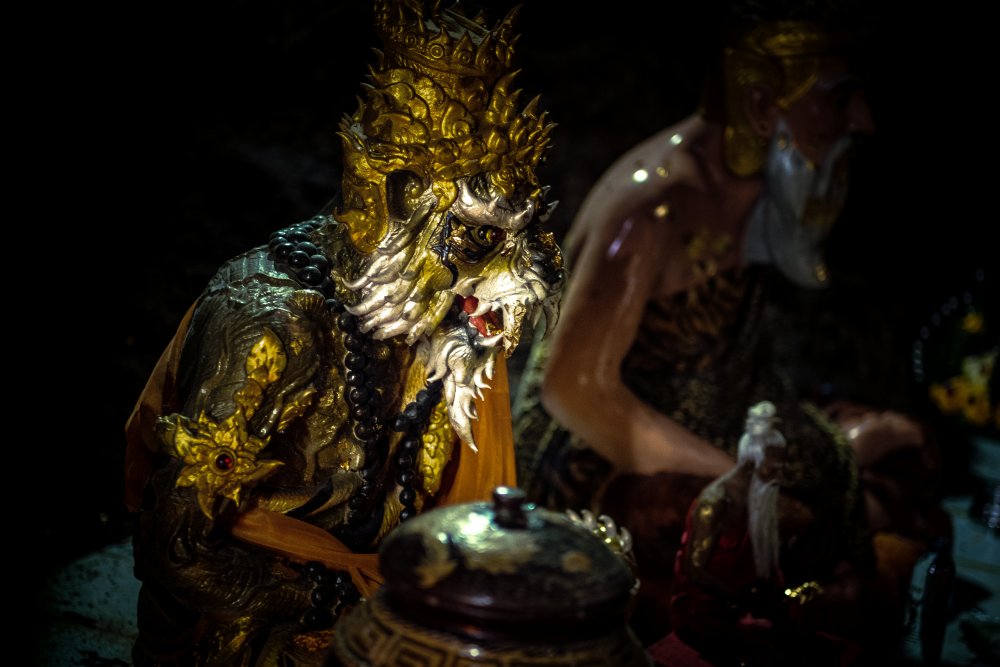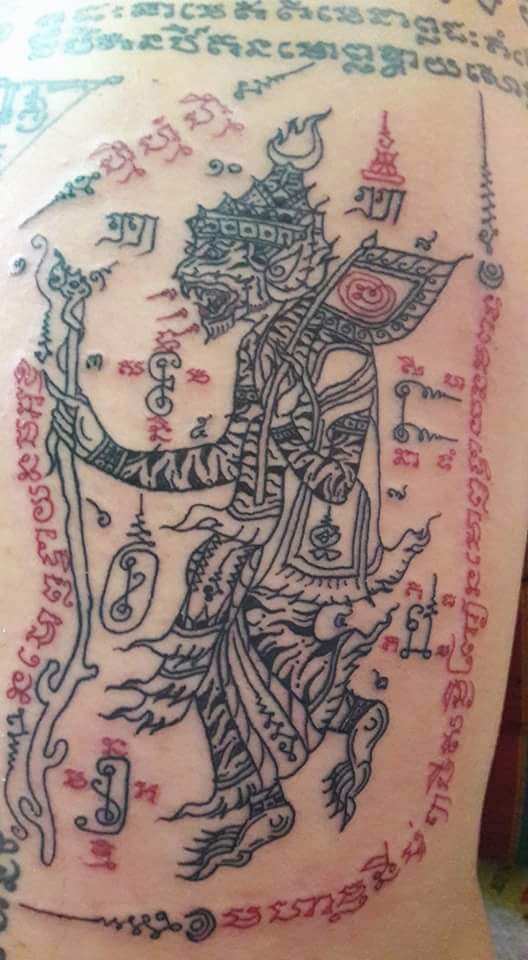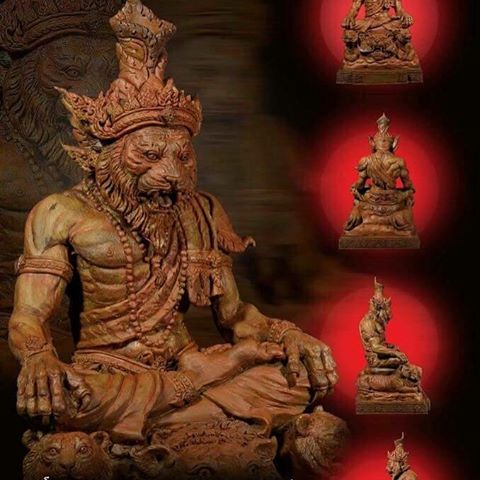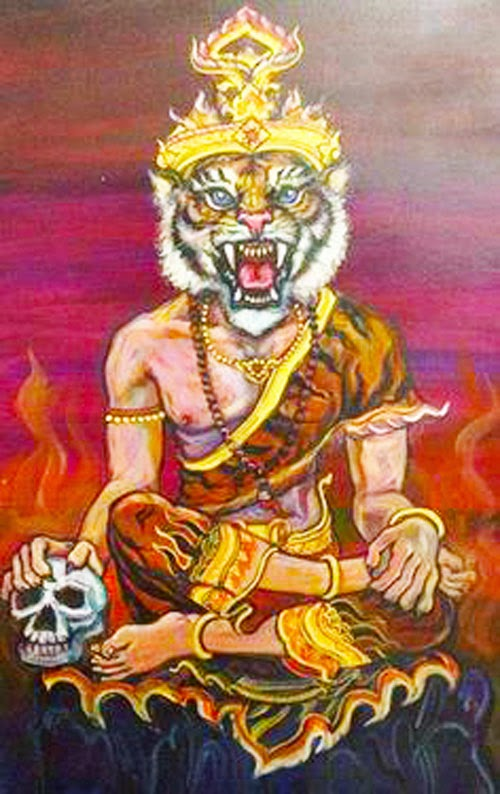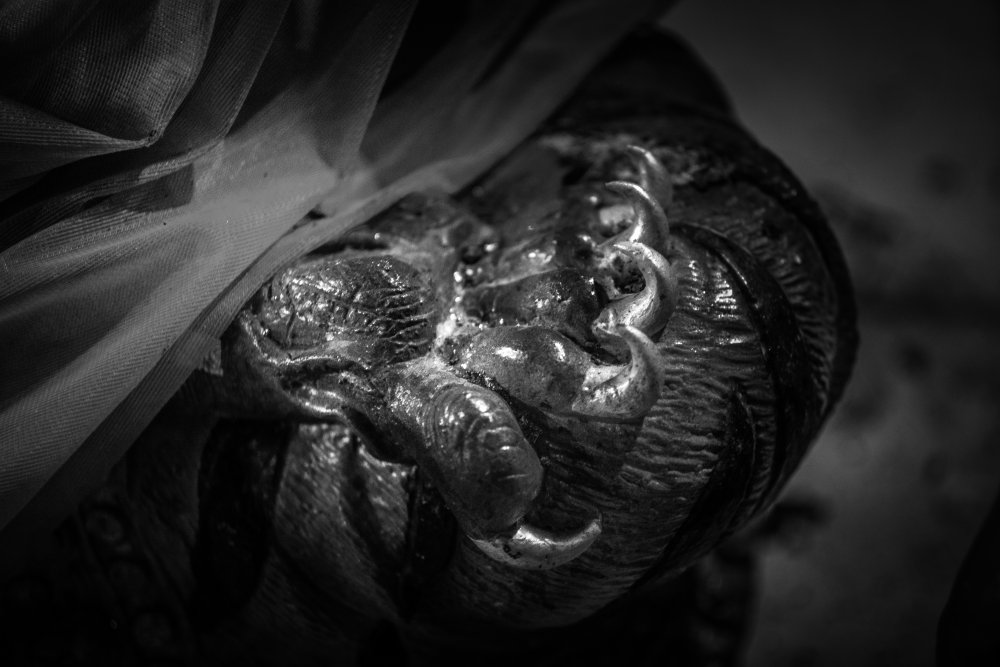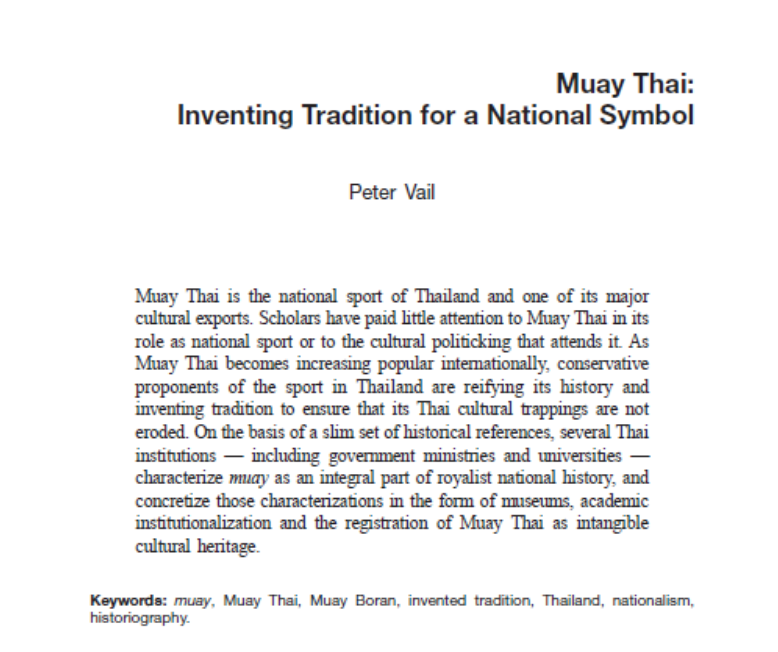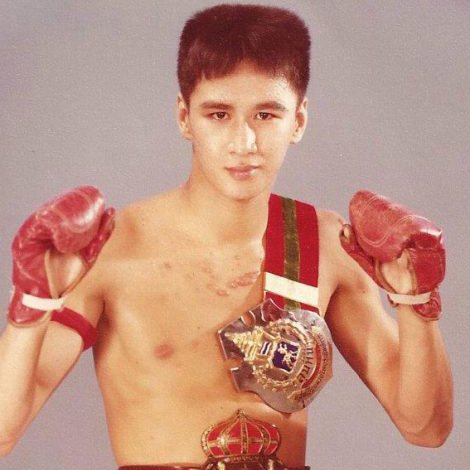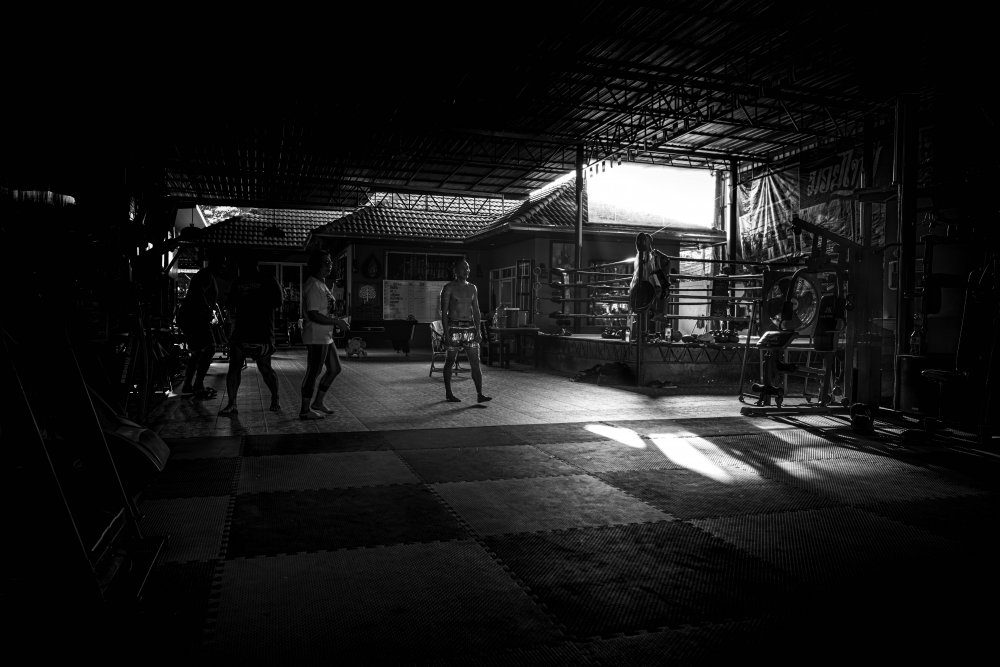-
Posts
2,264 -
Joined
-
Days Won
499
Everything posted by Kevin von Duuglas-Ittu
-
What does this mean for the role of rage and/or ferocity in Muay Thai, especially in the Muay Thai of Thailand? Because the Nak Muay himself/herself occupies a hybrid place in the culture, synthesizing holy and (possibly) unholy aspects of the human condition, Thailand's Muay Thai has a special offering to the Western fighter, and even viewer, who is drawn to fighting as an expression of aggression, anger, pride, frustration, rage, either as they occur in themselves or in society. When you train in Thailand you'll hear the Jai yen yen admonition, "Have a cool heart", which can work as a counterbalance to all the hot-hearted drive to the need to fight, or enjoy fights. But Thailand's Muay Thai is not just Jai yen yen. It rather creates a vehicle for sudden violence, even ferocious violence, which can erupt in only a flash, or a wave. Or, it can pulse in a Muay Khao derning. The Buddhistic take on anger and reactive passions certainly about controlling oneself, and ultimately one's mind. But the Tiger Ruesi figure gives us something more. A kind of magical balance where the two sit in repose with each other. The surging Tiger terror lays there in the figure, pulling to mind things like the original meaning of the holy idea of "awe" as it relates to "awful". The full vitality of the Tiger, all of his thymotic real power, lays almost in reserve, perhaps. If you take this meaning and look at the incredible Muay of the Yodmuay of the Golden Age, I believe you can see this simmering vitality on almost all the great fighters, whether it is Samart the Tiger who almost never has to get up from his rest in the shade, or Dieselnoi who stalks, counters and then threshes his opponent savagely, or Karuhat who silkily moves from rope to rope, and then strikes a mortal blow, decisively turning the fight. At the highest levels this seems to be the art of Muay Thai, and as we look at the yodmuay of the past we can see the infinite variety of the ways that Tiger Energy has been alchemized into personality and style. As a western fighter coming to Thailand this is what, perhaps, the art and training has to offer. A more nuanced and pronounced way to express your thymotic energies. It is not just "Jai yen yen", it is Jai yen yen so that the Tiger can come out beautifully, expressively, in control of itself, striding and in full glory. At least that is what it seems like to me, come from the years I've spent in gyms all over Thailand, and from being in the presence of so many past great fighters. They all are Tigers.
-
It is worth noting that the Nak Muay in Thailand existed positioned in a kind of Tiger Ruesi place. He (she) embodies characteristics of both the monk, and the Nakleng (gangster). The Nak Muay is a kind of were-hybrid figure, in terms of powers and expressed affects. He (she) is both holy and unholy, in the art and violence of Muay Thai: The above graphic is from the article Thai Masculinity: Positioning Nak Muay Between Monkhood and Nak Leng – Peter Vail which examines academic Peter Vail's argument that Nak Muay are a kind of hybrid figure in Thailand. You can read the original excerpt of his dissertation here: ad hoc title: Thai Masculinity: Positioning Nakmuay Between Monkhood and Nakleng PDF In this comparison Peter Vail draws on the Tiger, but in a differing way. He argues that in the way that forest monks used spending a night in a Tiger-prawled forest, creating a calmness before that potential ferocity, that is facing Tiger Energy to produce thudong, in this way Nak Muay are like them. In a certain regard one might say that facing the Tiger Energy before you, and within you, and creating a synthesis, is the spiritual (affective) challenge of the Muay Thai fighter in Thailand. The Tiger Ruesi epitomizes and heightens just what the Nak Muay is.
-
Now, the history of high level Muay Thai is not filled with "Tiger Energy" fighters. In fact we've filmed with almost a 100 legends and ex-fighters and only come upon it in a few times. Notably, when in the ring with Sagat Petchyindee, you can just feel it emanate off of him. You can see it in this slow motion we took of his shadow: (link divergence: You can see it more in particular in the Muay Thai Library sessions we filmed with him: #69 Sagat Petchyindee 3 - Muay Maat Tigers & Snakes (67 min) watch it here , #60 Sagat Petchindee Session 2 - All the Strikes Tuned and Dangerous (101 min) watch it here , #38 Sagat Petchyindee (part 2) - Maximum Damage (61 min) watch it here , #26 Sagat Petchyindee - Explosive Power (57 min) watch it here ) This is to say, the higher level affect dynamics of Thailand's traditional Muay Thai is not fundamentally a synthesis of Tiger Energy, per se, but Tiger Energy does propose a kind of extreme (thymotic) energy what indeed needs to be given a vehicle of artful expression. And, at least to my eyes, the figure of the Tiger Ruesi holy man, brings this alchemy of thymotic anger and rage into close view. In the west we have synthetic/dichotomous figures which talk to that problematic. The Minotaur of Ancient Greece The Gothic Werewolf Contemporary Hulk It is as if Western Civilization has been trying to process this rage/pride/thymos synthesis for 2,500 years. That is what make the art and tradition of Muay Thai so very interesting to the western problematic. And, suggestively, the Thai Buddhistic tradition of magical synthesis, which aim to generate this resolution at the highest level. In the larger scope, it is the way in which Thailand's Muay Thai processes and redirects typified western affects of rage and anger (and the host of emotions expressed by aggro-fighting in western oriented promotions) into an art form of spatial and personal control, maintaining their edge and sharpness, but held more close to the vest, honed liked a Japanese sword...perhaps, that proves the value of Thailand's historical Muay Thai, a martial combat sport that has been closely braided to long standing principles of Buddhism. That a Tiger Ruesi can exist as an acme holy figure in Thailand's Buddhism points the way toward the resolutions and expressions of ferocity by the Nak Muay that make Thailand's Muay Thai like no other fighting art.
-
On our visit to Wat Khao Aor in Phatthalung, a 900 year old temple that was built around a sacred cave that likely featured worship for a much longer time. There are stories about the elephant-like shapes in the stone of the cave walls for instance. In that cave now are a host of spiritual figures/statuary as the cave has been a place of organized ceremonial retreat, mediation & merit-making for centuries. Among these figures is a Tiger Ruesi, something that has long captured my imagination, especially as I try to figure out the affective/spiritual path of the Nakmuay in Thailand, the particular way in which Muay Thai mitigates, translates, hones & even amplifies violence, alchemizing it into a artform, and a possibly a minor practice of transcendence. The Tiger Ruesi - and there are many differing tales, and likely differing Ruesi with a Tiger head, is a spiritual (magical) hermit who advanced in his (dark?) arts so thoroughly his head transformed into one of a tiger. One such tale of this event involved dualing Ruesi testing their magic upon each other, but whatever the stories, the figure itself expresses the incredible harmony/dichotomy of a holy man holding both the ferocity of a Tiger's Truth (energy), and the Buddhist epitome of equanimity. He, like the figure itself, feels like a living contradiction...or, a reconciliation of opposites. Below are two photos I took of the figure: It's the second of these photos that I'm really interested in, but the first captures some of that flaming, gold-encrusted (there is leaf on his fangs, etc), eruptive energy in the Tiger. The genuine terror of what a Tiger is. I think for us in the West we have domesticated the Tiger in our minds, a sleek, sexy, dynamic beautiful energy, but that is because we are not connected, historically, to environments where if you walked out alone into the forest or the jungle you might not come back, due to a Tiger. The Tiger is perhaps close to the image we have had of a Great White Shark, which might mercilessly snatch you while swimming, or maybe the uncompromising hunt energy of a wolf. That is the energy that has become magical. The synthesis/tension of the Tiger Ruesi proposes a Thymotic energy resolution. (link divergence: Thymos is this. How Homer treated Thymos. And some of thymos is this. Thymotics and anger. But this is maybe the best treatment of what Thymos is). It is the surging dignity/pride/rage that comes from what feels like an animal core. The Tiger Ruesi, especially this one, seems to have come to hold in one hand both the terrifying ferocity of thymotic rage and Buddhistic repose...like a carefully balanced flame that burns calmly and unwavering in a breezeless room. Most Tiger Ruesi figures show him much more in repose. But this figure is practically erupting with the energy in his face. But...what is very cool is his up-turned clawed palm, an aspect of his meditative posture. This small detail of the statue is just enormous. The claws, the weapons and expressions of his seemingly very nature, are open and relaxed. Anyone who has spread the claws of a cat's paw knows the natural tension that closes them back up. The figure must be so relaxed to have his clawed palm upon up so much. And that one thumb claw that really hangs down drives home the meaning. It's truly spectacular, the poles of the spectrum of experience.
-
Funny you should ask! We're trying out a new column on our Patreon, free for everyone. Below is an end summary of how/where to watch, but Phan is right now covering the most recent fights, and also what fights to look forward to, twice a month: How to watch Stadium (BKK) Muay Thai? Some people find it hard to find a place to watch elite circuit fights and there are many reasons for this, whether it be the language barrier, significant time zone differences, difficulty following the sport or whatever else. In fact, it has never been easier to watch shows live than today. Nowadays, there may be about a dozen shows per week but only three shows are behind paywall (Chefboonthum and Rajadamnern, no way to pay the iPPV without a Thai credit card) and only one requires a VPN (Channel 7). Otherwise, the rest are all either on Facebook or Youtube (or adintrend). Rajadamnern Stadium typically publishes the entire show 12 hours after the live show itself and Chefboonthum does the same a few days after on Facebook. The best free (no paywall) shows of the week are typically Sia Boat (Petyindee)’s Muaymumwansuk show on Fridays at 6 PM local time, Muay Jet Si at Channel 7 Stadium on Sundays at 2 PM local, Suk Jitmuangnon (only live link) on Saturdays at 4:30 PM local, and Suk Jao Muay Thai at Siam Omnoi Stadium, every Saturday at 12 PM local. Following the sport has also gotten significantly easier with the advent of websites like Muay Thai 2000 and English speaking pages dedicated to the sport on essentially all major social media platforms besides Youtube. See his most recent article here: Best of BKK Muay Thai: fights you missed, fights coming up: vol 2 (early Nov, 2020) https://www.patreon.com/posts/43771237 This way not only do you know where to watch, but also what you are looking at, what the storylines are for all the best fights.
-
This study found that those with physical abuse in childhood (as differing from sexual abuse), had a heightened reaction to sad faces, due to the right amygdala (which broadly, maybe more stimulated in the follicular phase): Childhood Trauma History Differentiates Amygdala Response to Sad Faces within MDD
-
This study suggests that sexual abuse victims and those with PTSD have a heightened anxiety response to fearful AND neutral faces, through the left amygdala. In female fighters it is possible that Luteal Phase left amygdala stimulation could amplify this: read it here: Amygdala habituation to emotional faces in adolescents with internalizing disorders, adolescents with childhood sexual abuse related PTSD and healthy adolescents
-
one study: the left amygdalais more closely related to affective information encoding with a higher affinity to language and to detailed feature extraction, and the right amygdala to affective information retrieval with a higher affinity to pictorial or image-related material. Furthermore, the right amygdala may be more strongly engaged than the left one in a fast,shallow or gross analysis of affect-related information. read the study here: Differential_Contribution_of_Right_and_Left_Amygda.pdf They found in 17 normal subjects thatthe evaluation of unpleasant visual stimuli activated(among other regions) the left amygdala. This activa-tion not only held for fear-related, but for a wide rangeof unpleasant stimuli.Studying regional cerebral blood flow changes in re-sponse to the presentation of faces with different emo-tional expressions, has provided a major basis for es-tablishing a differential role of the left and right amyg-dala in cognitive information processing. Interestingresults were obtained in a series of studies by Mor-ris [85, 87, 88]. Morris et al. [85] found enhanced...On the other hand, Mor-ris et al. [87, 88] found a significant neural response inthe right, but not the left, amygdala to masked presen-tations of a conditioned angry face. Combined, thesefindings suggest that unconscious (masked) process-ing is mediated more readily by the right, and con-scious processing more readily by the left amygdala(among other structures).
-
In some Follicular = left, Luteal = right from wikipedia, the amygdala Hemispheric specializations In one study, electrical stimulations of the right amygdala induced negative emotions, especially fear and sadness. In contrast, stimulation of the left amygdala was able to induce either pleasant (happiness) or unpleasant (fear, anxiety, sadness) emotions.[10] Other evidence suggests that the left amygdala plays a role in the brain's reward system.[11] Each side holds a specific function in how we perceive and process emotion. The right and left portions of the amygdala have independent memory systems, but work together to store, encode, and interpret emotion. The right hemisphere is associated with negative emotion.[12][13] It plays a role in the expression of fear and in the processing of fear-inducing stimuli. Fear conditioning, which occurs when a neutral stimulus acquires aversive properties, occurs within the right hemisphere. When an individual is presented with a conditioned, aversive stimulus, it is processed within the right amygdala, producing an unpleasant or fearful response. This emotional response conditions the individual to avoid fear-inducing stimuli and more importantly, to assess threats in the environment. The right hemisphere is also linked to declarative memory, which consists of facts and information from previously experienced events and must be consciously recalled. It also plays a significant role in the retention of episodic memory. Episodic memory consists of the autobiographical aspects of memory, permitting recall of emotional and sensory experience of an event. This type of memory does not require conscious recall. The right amygdala plays a role in the association of time and places with emotional properties.[14]
-
We filmed an entire session at Sangtiennoi's gym, just to give an inside look at what training there is like, one of the more "authentic" Muay Thai gyms with a history of training high level westerners as well. [edit in, November 2021 - seeing that I posted this, Sangtiennoi has since sadly passed away. The gym is still open and being run by his wife and his son Moses who have survived him.]
Footer title
This content can be configured within your theme settings in your ACP. You can add any HTML including images, paragraphs and lists.
Footer title
This content can be configured within your theme settings in your ACP. You can add any HTML including images, paragraphs and lists.
Footer title
This content can be configured within your theme settings in your ACP. You can add any HTML including images, paragraphs and lists.

